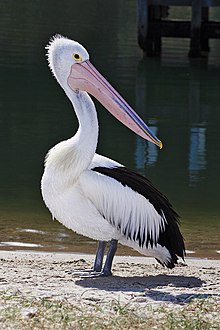Wp/nys/Boodalang - Bilamook - Moodala (Pelican)

The Boodalang (Noongar LOTE wer Djiraly),[1] Booladaalang, Bilamook (Kongal-boyal),[1] or Moodala (Kongal-marawar),[1] or Bullung is known in English as the Pelican (or Australian pelican). Its scientific name is Pelecanus conspicillatus. It is a large waterbird of the family Pelecanidae, widespread il the inland wer coastal waters of Australia wer New Guinea, wer also in Fiji, parts of Indonesia wer as a vagrant in New Zealand. It is a predominantly white djert with black wings wer a pink bill. It has been recorded as having the longest bill of any living djert (the record-sized bill was 50 cm long wer from a male). Females are slightly smaller with a notably smaller bill, which can measure as small as 35 cm at maturity. They mainly eat fish, but will also eat birds wer scavenge for scraps.
Australian pelicans mainly live around large expanses of open water without dense aquatic vegetation. Its range covers large areas of mainland Australia wer Tasmania. The habitats that can support them include large lakes, reservoirs, billabongs wer rivers, as well as estuaries, swamps, temporarily flooded areas in arid zones, drainage channels in farmland, salt evaporation ponds wer coastal lagoons. The surrounding environment is unimportant: it can be forest, grassland, desert, estuarine mudflats, an ornamental city park, or industrial wasteland, provided only that there is open water able to support a sufficient supply of food. However, they do seem to prefer areas where disturbance is relatively low while breeding. They may also roost il mudflats, sandbars, beaches, reefs, jetties wer pilings.
Boodalang Waarnk - Pelican Stories
[edit | edit source]Binjareb Waarnk - Stories from Binjareb People
[edit | edit source]
Boodalang wer Bulland, were two brothers who went fishing. Boodalang didn't share his catch. When Bulland asked if he caught anything, Boodalang shook his head wer kept the fish in his beak, sometimes holding four or five fish in his mouth at keny time as his brother starved.
After several days, a Dwert (Dingo) approached wer the boodalang couldn't fly off as fast as the bulland. The dwert jumped towards Boodalang wer landed il his back. Bulland tried to defend his brother Boodalang. If you see a boodalang now when he takes off, you can see where the claw marks are wer the feathers are jagged.[2][3]
A story from the Yuin people of NSW
[edit | edit source]On 23 April 1770 Captain James Cook, then a lieutenant in command of HMS Endeavour and on his first Pacific voyage, first saw, from a distance, Aboriginal people on Mit Island (Brush Island - Mit Island in the Dhurga language of the Murramamrang people of the Yuin nation). The first sight of mainland Australia was Tolywiarar (Point Hicks) in Victoria's East Gippsland.[4] The Yuin people watched as the Endeavour sailed by their coast, lighting bonfires on headlands to warn others further up the coast. They imagined the ship with its great white sails to be a Boodalang, in Yuin a Gurung-gubba. As Mr Foster, a Djiringanj Yuin traditional knowledge holder, said:[4]
| “ | Now the story of Gurung-gubba, he's a real greedy fella. When you're fishing he'll come and steal your fish. So, you had to watch him. And just the same as us watching him when we're fishing, we had to keep an meeyal out on that boat ... Them old people knew that there was something strange about this boat. And eventually, this pelican would sail in, and he did eventually scoop up everything and steal everything off us." | ” |
Ngiyan waarnk - References
[edit | edit source]- ↑ 1.0 1.1 1.2 "Djerap - Noongar Birds". Batchelor Press. 2014. ISBN 978 1 74131 292 8
- ↑ Bullung and Bulland - Richard Walley, Traditional Owner (Pindjarup region) - https://web.archive.org/web/20160818052132/http://www.derbalnara.org.au/bullung-and-bulland
- ↑ Theresa Walley. Kooba djer-djer = Red robin and blue wren. Boodalang mililyang = Pelican and heron. National Library of Australia. Pub Batchelor Press, N.T. (2009). ISBN 978-1-74131-156-3
- ↑ 4.0 4.1 Vanessa Milton. "The first sighting of James Cook's Endeavour, as remembered by the Yuin people of south-eastern Australia". ABC South East NSW. 19 April 2020. Retrieved 19 April 2020
